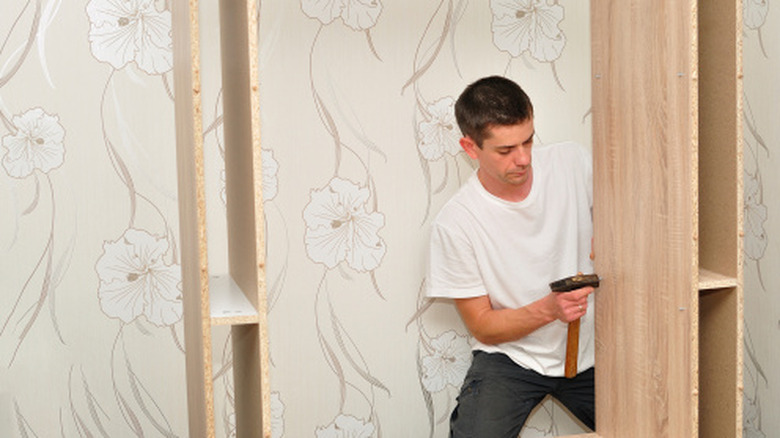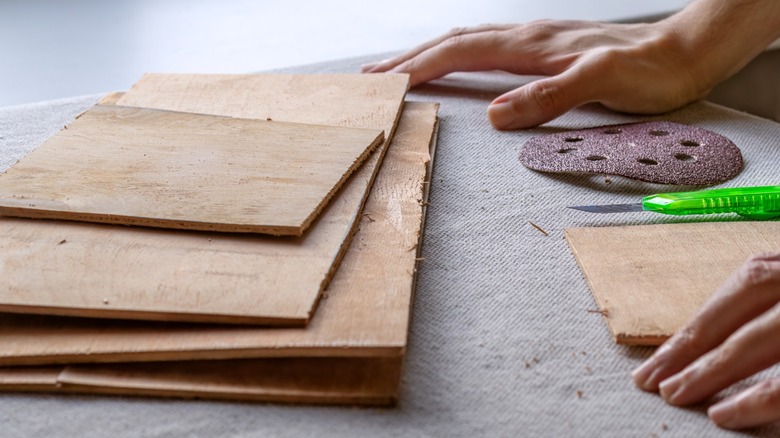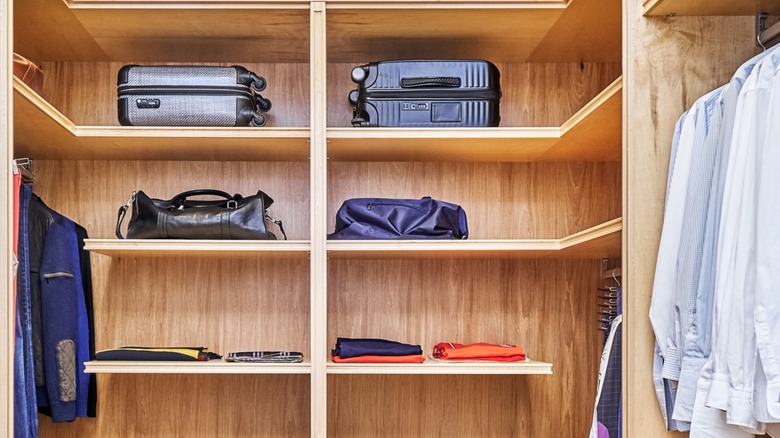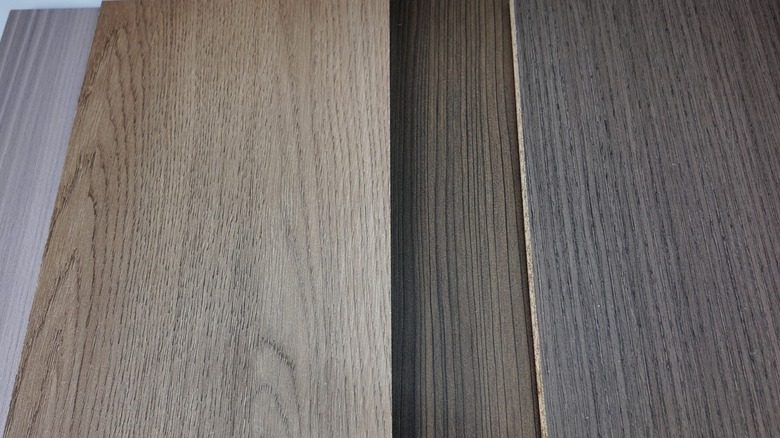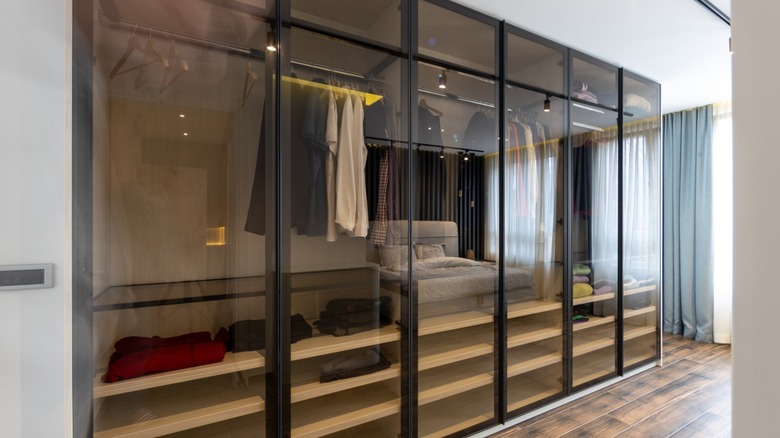The Best And Most Durable Materials To Use For Closet Built-Ins
Most homeowners know the frustration of closet failures. That dreaded crack when you reach for something, a drawer that keeps coming loose, or a closet rod that suddenly drops your carefully hung clothes on the floor. These common problems often point to the same thing — not every closet material will give you great results.
It's easy to choose closet components based on price alone. But within a few years, or even a few months, things start falling apart. That's usually when the real lesson kicks in: Investing in the right materials from the beginning saves time, money, and a lot of frustration down the line. When you're building closet systems that need to open, close, support weight, and stay looking good for years, your choice of material matters a lot. The good news is that durable doesn't have to mean expensive, a perfect example being plywood. With smart choices, you can buy or build a closet that lasts a long time without breaking the bank.
First, you want to confirm that a built-in closet is truly the best option for your home and lifestyle. Then you can compare the best materials across different price points, explore why some materials perform better than others, learn where it's worth investing for durability, and determine where you can save without sacrificing quality. Here are the best and most durable materials to use when building a closet system.
Plywood
Plywood is one of the most popular and practical materials for building closets because it's strong, lightweight, and more affordable compared to solid wood. Plywood is made by stacking thin layers of wood (called "plies") and gluing them together. This layered design makes it very stable and helps it avoid issues like warping or shrinking.
One reason plywood works so well for closets is how stable it is. Solid wood can expand, contract, or warp when humidity changes, but plywood stays the same size and shape in different conditions. This makes it perfect for closet parts like shelves, drawers, and cabinet sides that need to stay straight and sturdy over time. Plywood is also very strong. The layers of wood are arranged with their grains in different directions, which helps distribute weight evenly. This means plywood shelves can hold heavier items, like folded clothes, without bending. However, for very long shelves or heavy storage, you might still need to install extra support to prevent sagging.
Another advantage of plywood is how easy it is to work with. It's lighter than solid wood, so it's easier to handle and install. It also holds screws, nails, and glue well, making it a great choice for custom closet designs that might need adjustments during installation. Plywood comes in different grades and types, so you can choose the right one for your needs. For example, cabinet-grade plywood has a smooth finish and is great for visible parts, while construction-grade plywood works well for hidden structural pieces.
Solid wood
Solid wood remains the premium choice for closet built-ins, offering natural beauty and sophistication that few other materials can replicate. When properly maintained, its durability is impressive. Unlike engineered materials that may break down over time, solid wood components can last for decades. Its longevity comes from its natural structural integrity and its ability to withstand the daily wear and tear. And even when it does show signs of age, it can often be refinished rather than replaced.
Another major advantage of solid wood is its flexibility in design. Homeowners can choose from a wide range of wood species to match their aesthetic goals. Solid wood also takes stain and paint well, offering nearly unlimited options for color customization. This versatility makes it a favorite for those who want built-ins that match the rest of their home's design.
From a property value standpoint, solid wood closet systems are often seen as upgrades. They're frequently mentioned in real estate listings as premium features, which can help improve both a home's marketability and resale potential. However, despite these advantages, solid wood still has its drawbacks. Most notably, it's expensive, often significantly more so than engineered alternatives. For many homeowners, the cost alone can be a dealbreaker. It also requires more maintenance. Because it's a natural material, solid wood can respond to changes in humidity and temperature, leading to issues like warping, cracking, or expansion if not properly cared for.
Melamine
When it comes to durability, melamine stands out as one of the strongest options for closet materials. Unlike traditional wood, melamine is made from organic chemical compounds engineered to outperform standard wood products in both strength and longevity. Its durability comes from how it's made. Instead of layering thin sheets like plywood, melamine is manufactured as a dense, uniform core with a hard laminate coating. This design makes it highly resistant to warping, moisture, and heat, common issues in closets that see daily use.
Its affordability is another key advantage. A full custom melamine wardrobe typically ranges from $1,500 to $5,000, while individual shelving units often cost just a few hundred dollars. Comparable systems made from other materials can be significantly more expensive and may offer fewer finish or color options. Despite its strength, melamine is also relatively lightweight, which makes it easier to install and modify if needed.
Of course, no material is perfect. While melamine is highly durable, it's not completely scratch-proof. Care should be taken when moving or adjusting closet components to avoid surface damage. And while it resists moisture better than many alternatives, constant exposure to damp clothing or high humidity can eventually lead to damage over time. For homeowners comparing closet material options, melamine stands out for its durability, affordability, and resistance to wear and moisture, making it a reliable choice for built-ins. Its customization potential and clean, modern finish only add to its appeal.
Materials you might want to avoid
Budget-friendly materials can be tempting, but some come with trade-offs that will cost you more in the long run. If durability is a priority, one material you should avoid is particleboard. While its low price point makes it initially appealing, particleboard tends to sag under moderate weight.
Standard wire shelving systems are another cost-effective option that often disappoints. The thin metal construction tends to bend under moderate weight and may eventually pull away from walls over time, causing drywall damage. Beyond that, the most frustrating problem for homeowners is wire shelving's tendency to leave impression marks on folded clothes and snag delicate fabrics. They also rarely complement traditional home aesthetics and generally don't add visual appeal or resale value to a space.
Clear glass shelving, though aesthetically appealing, presents practical challenges in daily use. Its fragile nature makes it unsuitable for holding heavier items, and the risk of it breaking poses safety concerns, particularly in reach-in closets where you may frequently move items around. Glass shelves also require significantly more maintenance to keep free of fingerprints and dust. That said, you don't have to stick with a single material. Mixing and matching can be both practical and stylish. A common and effective pairing is melamine with solid wood. The wood adds strength and structure, while melamine contributes a smooth, durable finish that resists daily wear. This kind of hybrid approach helps create a closet system that feels high-quality without breaking your budget.
